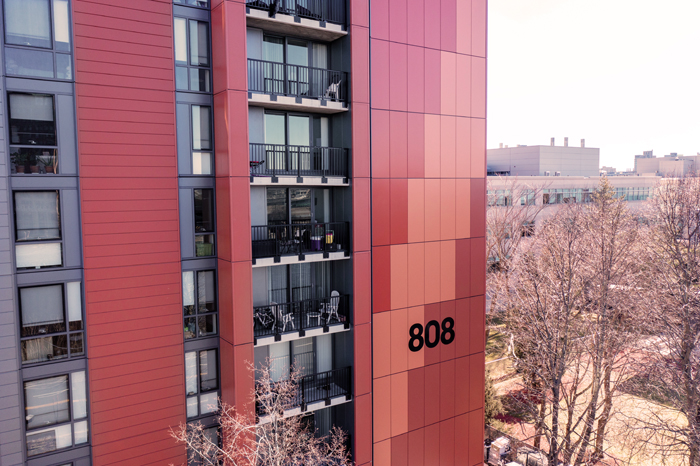Retrofits: A Key To Reducing CO2 Emissions In The Nation's Built Environment

Retrofits provide an opportunity to improve efficiency and make buildings more sustainable. They can also have a dramatic impact on appearance. Shown above is 808 Memorial Drive in Cambridge, Massachusetts. The building was retrofit with insulated metal
panels from Kingspan.
 |
Brent Trenga |
By Brent Trenga, Sustainability Director of Kingspan Insulated Panels North America
Deland, FL — Retrofits are key to reducing rising greenhouse gas (GHG) emissions in the built environment, according to new research by 3Keel and Kingspan. The study revealed that U.S. emissions from the built environment have increased by 3% in the last decade –
a trend that looks set to continue. The research warns that reductions in GHG emissions from buildings are reversing in the U.S. and the nation’s building stock is “far off track for reaching net zero by 2050.”
According to the report, over the next 20 years the U.S. must reduce building emissions by an additional 73% to align with the country’s net zero scenario.
Compounding the building emissions problem is the aging of U.S. buildings. The average age of the nation’s commercial building stock is approximately 55 years. The report pointed to retrofitting as a key intervention for improving energy efficiency
and decreasing energy demand to reduce the GHG emissions generated by the country’s older building stock.
Urgent need to step up retrofitting in the U.S.
Retrofitting is urgently needed to mitigate the far reaching and damaging impacts of climate change including changing precipitation patterns, rising sea levels, more acidic oceans, and increasing extreme weather events.
The recently released Fifth National Climate Assessment revealed that the U.S. average temperature has increased by 1.3°F to 1.9°F since 1895, and most of this increase has occurred since 1970. Temperatures are projected to rise another 2°F
to 4°F in most areas of the U.S. over the next few decades.
One of the biggest benefits of retrofit projects is they mitigate much of the embodied carbon emissions that are generated by the construction of new buildings. Retrofitting buildings can save between 50-75% of a building’s embodied carbon (the
carbon emissions released during the lifecycle of building materials).
Additionally, retrofit projects that reduce energy consumption of a building positively impact the environment by reducing carbon emissions. Integrating healthy materials, energy efficient lighting, thermally efficient building envelopes, renewable energy
and other sustainable strategies all work to minimize the environmental impact of buildings and help combat climate change.
Operational and financial benefits of retrofitting
In addition to environmental benefits that are key to helping mitigate climate change, building retrofits also offer a wide range of long-term operational and financial benefits.

From their industrial and cold-storage origins, insulated metal panel systems are now difficult if not impossible to discern from traditional architectural metal wall systems.
Insulated metal panel systems are much more versatile than they used to be, and architectsReplacing poor insulation, outdated HVAC systems and leaky building envelopes not only increases energy efficiency but can reduce maintenance costs. The average
reduction in operating costs in the first 12 months for green renovations and retrofits of existing buildings is 11.5%, and over five years, these buildings yield a cost savings of 17%, according to a market report by Dodge Construction Network.
Retrofit projects that prioritize sustainable building practices are also more attractive to potential buyers and tenants and command higher rental and resale value. According to JLL, evidence now shows that green certifications like LEED and BREEAM result
in a rent premium of 6% and a sales premium of 7.6%.
Additionally, building retrofits can increase the lifespan of existing buildings. Updating HVAC systems, electrical systems and windows, improving insulation, and addressing structural issues can extend the useful lifespan of buildings.
A viable pathway to net zero
It can take between 10 and 80 years for a new, energy-efficient building to overcome the negative climate change impacts that were created during the construction process. That points to reusing buildings and retrofitting as a viable pathway to net zero.
According to research by JLL, in the global north, retrofitting rates need to triple from barely 1% today to at least 3% of existing buildings per year to meet decarbonization targets.
There are many examples of successful retrofit projects that demonstrate the positive impact and benefits of updating buildings instead of razing them. One recent example was the renovation of the mixed-use building at 808 Memorial Drive located in Cambridge,
Massachusetts.
The building, which is situated on the banks of the Charles River, consists of residential and commercial units. It was in need of a renovation that would meet high standards of energy efficiency and sustainability. To meet these standards, architects
selected insulated metal panels with high thermal performance.
These panels offer excellent insulation properties, which help to reduce the amount of energy needed to heat and cool the building. This, in turn, helps to reduce the building's carbon footprint and operating costs.
Sustainable in design, the insulated metal panels used in this project are manufactured using a low-energy process, which reduces their environmental impact. These panels also contain a percentage of recycled content and the steel facers are fully recyclable
at the end of their useful life, further reducing their environmental impact.
Shift to retrofitting
The U.S. could see a massive shift to retrofit projects due to increasing interest rates, the rising cost of building materials and limited availability of land for new buildings. That’s good news for the environment.
It is clear the pace of retrofitting needs to increase in the U.S. to reach net zero targets. Retrofitting existing buildings to make them more energy efficient and sustainable is a key part of reducing GHG emissions and accelerating progress on the pathway
to net zero.
About Kingspan Insulated Panels - North America

Kingspan
Insulated Panels – North America is a business unit of Kingspan, a
global company operating in more than 80 countries, with over 200
manufacturing facilities. Kingspan Insulated Panels – North America
manufactures and markets three groups of products at its U.S., Canadian
and Mexican facilities: insulated metal wall and roof panel systems for
commercial/industrial construction; insulated architectural panel and
façade systems for design-driven projects; and controlled environment
panels and doors for cold-storage and climate-controlled warehousing. In
addition to its commitment to quality and innovation, the company is on
the leading edge of the sustainability movement, offering best-of-class
products produced in state-of-the-art, eco-friendly facilities. To learn more visit www.kingspanpanels.us.



